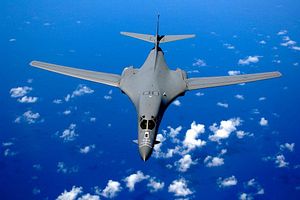The U.S. Air Force dispatched B-1B Lancer strategic bombers to the Indo-Pacific for a training mission last week. The U.S. Air Force’s 7th Air Wing sent two B-1B bombers on training missions to the region last week to demonstrate readiness during the COVID-19 pandemic.
“When the commander in chief says he wants four B-1B Lancers in the Indo-Pacific, we say ‘they’ll be there’ even in a pandemic,” said Col. Jose “Ed” Sumangil, commander of the 7th Bomb Wing.
“And that’s what we did on very short notice. We were able to make this happen because of the effort as a whole from Team Dyess to minimize the risk of COVID-19 transmission while sustaining our mission capabilities,” he said. The bombers flew from Dyess Air Force Base in Texas to Andersen Air Force Base on the U.S. territory of Guam in the Pacific Ocean.
From Guam, two B-1B Lancers flew to the South China Sea on a training mission, with one passing through the Bashi Channel separating Taiwan from the Philippines island of Luzon and another flying through the Celebes and Sulu Sea. U.S. Air Force KC-135R tankers provided support during the flights. Last month, two B-1B Lancer bombers from Ellsworth Air Force Base in South Dakota flew a sortie to the South China Sea as well.
Earlier in the month, a 9th Expeditionary Bomb Squadron flew through the East China Sea, where the United States has carried out regular transits to protest China’s establishment of a unilateral air defense identification zone in November 2013. The East China Sea deployment was designed to support U.S. Pacific Air Forces’ strategic deterrence missions, according to the U.S. Air Force.
Under its new dynamic force employment concept, the U.S. Air Force will end its continuous deployment of bombers to Guam and base them primarily in the continental United States. The U.S. Air Force ended its basing of strategic bombers in Guam in April.
“U.S. strategic bombers will continue to operate in the Indo-Pacific, to include Guam, at the timing and tempo of our choosing,” U.S. Air Force Global Strike Command said at the time in a statement. “We will maximize all opportunities to train alongside our allies and partners, to build interoperability, and bolster our collective ability to be operationally unpredictable.”
Introduced in 1986, the B-1B is a supersonic strategic heavy bomber. With a previous nuclear weapons delivery role, all B-1B Lancers have since been fully denuclearized and now serve an exclusive conventional standoff weapon and gravity bomb delivery mission. The B-1B’s internal bays are capable of carrying a range of payloads, including advanced, low-observable standoff weapons like the Joint Air-to-Surface Standoff Missile, or JASSM.
































